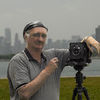1970's digital photos
Nov 21, 2013 08:44:55 #
I think it was mid to late '70s there was a shopping center kiosk fad that mated a television camera to a computer (DEC PDP/8) and used a wire matrix printer to print on pin feed paper. Does anybody have any recollection of this and can you point me to any documentation regarding this process? I have a good print-out and I'd like to document the process and donate the print-out to a local photography museum.
Thanks for any input.
Jim
Thanks for any input.
Jim
Nov 21, 2013 08:50:37 #
Nov 21, 2013 09:15:44 #
jmccl wrote:
I think it was mid to late '70s there was a shopping center kiosk fad that mated a television camera to a computer (DEC PDP/8) and used a wire matrix printer to print on pin feed paper. Does anybody have any recollection of this and can you point me to any documentation regarding this process? I have a good print-out and I'd like to document the process and donate the print-out to a local photography museum.
Thanks for any input.
Jim
Thanks for any input.
Jim
If I remember correctly, this process was used to print your photo on different items such as t-shirts. I believe it printed on an iron on type of paper so you could heat transfer the image to a shirt. DDo not know the name of this, but it was popular at carnivals and festivals.
Nov 21, 2013 09:23:12 #
In the 70's I used an Epson MX-80 dot matrix printer coupled to an old IBM word processor which I programmed to produce illustrations or diagrams. In the early 80's I acquired an Epson FX-80 and coupled this with a Sinclair ZX81 and an Amstrad computer which between them produced dot matrix representations of B&W photos. If viewed from a reasonable distance, 3-4 feet, they were not bad, close up it was difficult to see the image.
I never came across photo booths doing this though.
I never came across photo booths doing this though.
Nov 21, 2013 09:28:19 #
Yes, I remember the process, but never used it - too expensive for us in those days.
My girlfriend however, had apicture of her daughter done for a banner for her room. It must have been some heating process to transfer the image and what was left was a piece of paper with dots - densely together for dark shades, fewer and further apart for lighter tints, but each group of dots contained in its own square.
It was not very hard to use it as a pattern for a cross stitch picture but Idid not keep the paper.
EstherP
My girlfriend however, had apicture of her daughter done for a banner for her room. It must have been some heating process to transfer the image and what was left was a piece of paper with dots - densely together for dark shades, fewer and further apart for lighter tints, but each group of dots contained in its own square.
It was not very hard to use it as a pattern for a cross stitch picture but Idid not keep the paper.
EstherP
Nov 21, 2013 11:09:56 #
jmccl wrote:
I think it was mid to late '70s there was a shopping center kiosk fad that mated a television camera to a computer (DEC PDP/8) and used a wire matrix printer to print on pin feed paper. Does anybody have any recollection of this and can you point me to any documentation regarding this process? I have a good print-out and I'd like to document the process and donate the print-out to a local photography museum.
Thanks for any input.
Jim
Thanks for any input.
Jim
Nov 22, 2013 06:36:48 #
I recall those "good old days" - the print-out actually used letters of various density to create the photo. No documentation, but for those youngsters here - the PDP-8 was one of the first computers "mass-produced" and was widely used in business and in colleges to train students. I took my first computer engineering course with one in 1970. It required an entire room with a raised floor for ventilation to keep everything cool. It was the size of a small car and had a staggering 64kb (that's kb!!) of memory. The hard drive was another huge machine, with discs about 18inches across. Programs and data were entered on punched out cards which were read with a card-reader. Students, after spending long hours on their programs, would then spend more long hours in the card room with typewriter-type machines that would punch one card (like a long notecard) for each line of code. When you had your big stack of cards you would go to the computer room and have the grad student load them into the card reader. Your program would then be put in the queue to be run, and the next day you would pick up whatever printout was generated to see if your program worked. Compare that to today's tablet computers!
Nov 22, 2013 10:05:49 #
I came across one of those at Heathrow, I still have the printout somewhere. It was a dot/pin matrix low-ish resolution image. Instead of being full-address graphics, it rendered the image by using different text characters to simulate a coarse gray-scale image. The size of the text characters placed an upper limit on the resolution.
Nov 22, 2013 10:16:02 #
sb wrote:
I recall those "good old days" - the pri... (show quote)
I remember when I attained the privilege of being alllowed to load my own cards in the college computer lab. (The computer was a shambling old Burroughs set up to pretend that it was an IBM360 so we could learn 360 assembly language on it.) A month later they installed video terminals and we could see what we were doing on a screen instead of having to decode a stack of cards. Still had to wait overnight for the printout.
Nov 23, 2013 00:06:44 #
I'm sorry to disagree, A PDP-8 would fit in a standard 19in wide rack and was about 3ft high. I used one to control test equipment. A PDP-10 was a large machine as described below. We had a cluster of those in our computer dept. along with some "supper computers".
sb wrote:
I recall those "good old days" - the pri... (show quote)
Nov 23, 2013 00:23:22 #
Johanna wrote:
I'm sorry to disagree, A PDP-8 would fit in a standard 19in wide rack and was about 3ft high..
I think the poster is confused with the PDP-6, which indeed take up a room. Mostly taken up by its power supplies and UPS batteries.
The world's first PDP-6 was delivered to a university in Western Australia. I know it well.
I do recall a primitive photo printer using an LA-36 printer from the early 70's. It printed using ASCI characters but the computer had to be programmed to generate the image.
I think the kiosk ones used a PDP-11 and a DEC LA36.
Nov 23, 2013 13:09:56 #
Terra Australis wrote:
I think the poster is confused with the PDP-6, which indeed take up a room. Mostly taken up by its power supplies and UPS batteries.
The world's first PDP-6 was delivered to a university in Western Australia. I know it well.
I do recall a primitive photo printer using an LA-36 printer from the early 70's. It printed using ASCI characters but the computer had to be programmed to generate the image.
I think the kiosk ones used a PDP-11 and a DEC LA36.
The world's first PDP-6 was delivered to a university in Western Australia. I know it well.
I do recall a primitive photo printer using an LA-36 printer from the early 70's. It printed using ASCI characters but the computer had to be programmed to generate the image.
I think the kiosk ones used a PDP-11 and a DEC LA36.
The printout I got is exactly like what you describe the output of the rig you speak of being, so I'm going to assume that my encounter was with one of them.
Nov 23, 2013 13:12:48 #
If you want to reply, then register here. Registration is free and your account is created instantly, so you can post right away.









